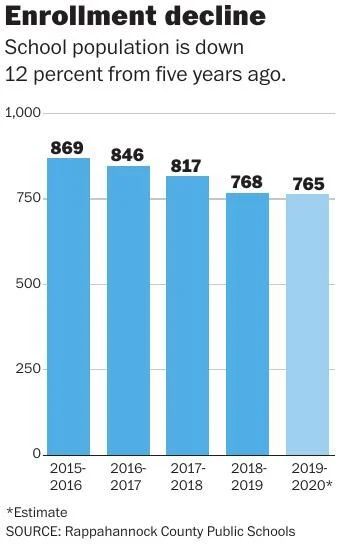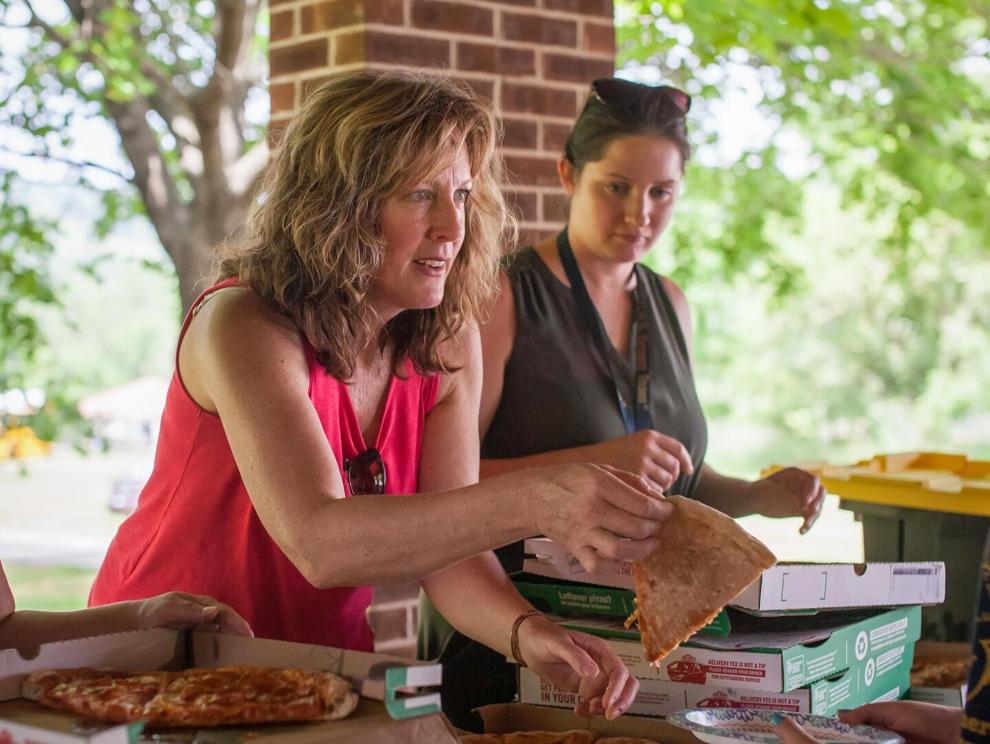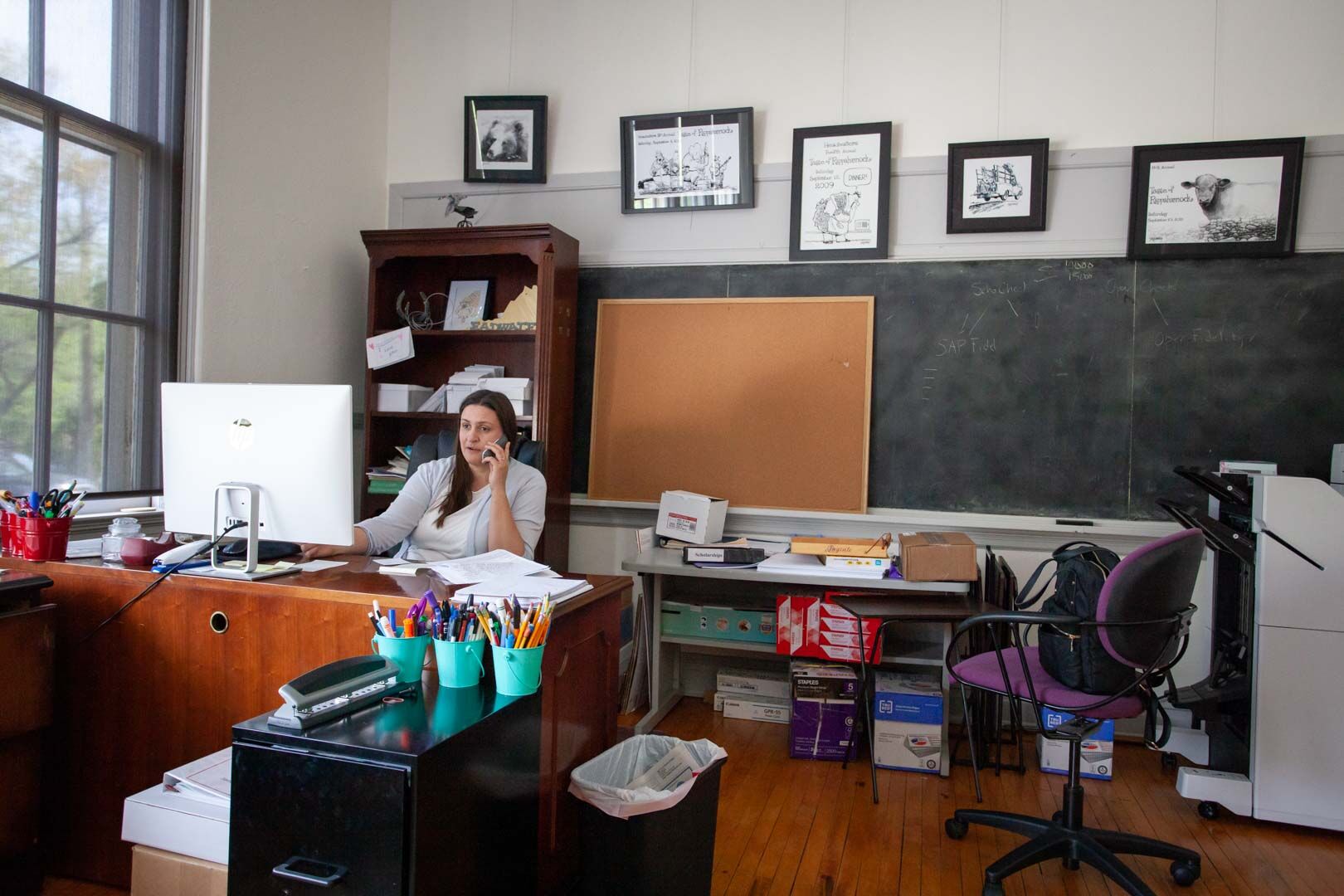Costs, declining enrollment prompt discussion of ‘What if’ consolidation scenario
It’s complicated.
So goes the relationship between Rappahannock County and its public school district.
In February, at a public meeting that included the school board and Superintendent Shannon Grimsley, Hampton Supervisor Keir Whitson raised what he called an “elephant-in-the-room” question. He asked why the county’s cost of funding the public schools doesn’t reflect the district’s dropping enrollment.
“When I campaigned door-to-door, I’d hear from people, ‘Please don’t raise my property taxes,’” Whitson said in a recent interview. “And some would add a vague statement to the effect that ‘We sure spend a lot on our schools.’”
Last May, when it appeared that children in Rappahannock and their parents were facing a long summer of pandemic-driven social isolation and child-care dilemmas, a group of local agencies and nonprofits — from the Headwaters Foundation and the Rappahannock Association for Arts and Community (RAAC) to the Child Care and Learning Center and Old Rag Master Naturalists — worked with the county’s Recreational Facilities Authority to set up a summer camp.
That group has become the Rappahannock Kids Coalition, and its program has evolved into the popular Wonderful Wednesday Day Camp on the weekday when, due to COVID restrictions, no in-person classes are held at the schools. Currently, 135 students of all ages are participating in the weekly gatherings at the 4-H Center in Front Royal. Funds from the federal government’s CARES Act paid for the camp last fall, but this semester, costs are being covered through a private, anonymous donation.
“The camp last summer was a great example of the community working with the schools,” said Jenny Kapsa, the school district’s Profile of a Graduate Coordinator who’s also director of the Wonderful Wednesday camp. “Whenever I need support for any of these programs, I get it immediately.”
Difficult questions
That, in a nutshell, reflects the seemingly disparate attitudes about Rappahannock County Public Schools (RCPS). On one hand, it’s seen by Whitson’s tax-sensitive constituents as the county’s biggest expense, and one whose cost doesn’t appear to align with a shrinking enrollment. On the other, the school district is often described as the community’s hub and as a big component of its social life, as seen by ample support from private donors and volunteers for school programs.
But the truth is, it’s not an either-or proposition. Whitson, for one, said he supports the school district, adding that he has never voted against its funding requests. He also applauded efforts by Grimsley to cut costs to the county, particularly through her ability to obtain grant money and find ways for staff members to handle multiple roles when possible.
“But it’s my job to at least ask the difficult questions that constituents have asked me,” he said. “And I want to be able to tell them something a little better than ‘I’ll look into it.’”
Whitson pointed out that in the proposed budget for FY 2022, the county’s support for RCPS will equal 60 percent of the revenue that it expects to generate through local taxes. But that figure drops below 50 percent when all the county’s estimated revenue, including funds from the state and federal governments, is taken into account. Grimsley has noted that that’s a lower percentage of support for public schools than in most neighboring counties.
Her efforts to reduce the county’s burden have been complicated by Rappahannock’s high Local Composite Index (LCI), the state’s formula for determining how much financial support it provides for individual public school districts. The two biggest factors affecting Rappahannock’s LCI are the market value of its property and the adjusted gross income of its residents. But because the county has a large amount of land in easement or eligible for land use exemptions, the value of its taxable property falls well below its market value, which only increased during the pandemic. That, in combination with Rappahannock’s high adjusted gross income — largely driven by the wealth of a relatively small number of residents — reduces state education funding.
The existing formula, said Grimsley, penalizes Rappahannock and a handful of other rural counties with wide disparities in income levels. “For a county that has a much higher student poverty rate than surrounding school districts, it doesn’t capture the needs of our students at all,” she said. “That’s a big issue.”
“What if”
The other big issue is the enrollment decline. According to the state’s official calculation, known as Average Daily Membership (ADM), the school district’s attendance had dropped from 869 students in 2015 to 765 last year. The ADM for this year is still being determined, but Grimsley believes it could go as low as 750. Ironically, actual student enrollment has risen to 810 this semester, she said, but the ADM calculation doesn’t include a significant number of students for which the school district is responsible, such as 40 kids currently in Pre-K.
But the overall downward trend has sparked speculation that if it continues, Rappahannock could one day seek to consolidate its public school system with those in neighboring counties. That possibility, in fact, has been a core subject in a recent series of “community conversations” organized by Headwaters, the nonprofit that has been supporting public education in the county since the late 1990s.
Such consolidations do occur, but generally involve a town or city’s school district merging with the surrounding counties.’ Earlier this year, for instance, the state’s Board of Education approved a consolidation of the town of Covington’s school district with Allegheny County’s. But, according to Virginia Department of Education spokesperson Charles Pyle, no consolidation of separate county school districts has occurred in the state to date.
Still, the “What if?” question sharpens the focus on the ties that bind RCPS and the community. Athletic Director Courtney Atkins, who doubles as the high school’s nurse, sees sports events as a unifying force.
“It’s what brings people together here,” she said. “We don’t have a community center. We don’t have a movie theater. But Friday night football games really bring people out.”
For Lynnie Genho, executive director at Headwaters and the mother of five children in RCPS, the schools are where a lot of local residents find their social networks.

The schools are where a lot of residents find their social networks says Lynnie Genho, executive director at Headwaters Foundation. (Photo/Luke Christopher)
“Most of the people I interact with, I see them around school,” she said. “And I’ve never felt that more strongly than this past year when I haven’t been able to interact with them.”
Ag education
Not surprisingly, the pandemic has weakened some of the links between the schools and the community. The free yoga, cardio and strength training classes RCPS offered to county residents through its Commit to Be Fit program had to be put on hold. So was an effort to connect students with Rappahannock businesses through internships, as were programs where volunteers come into the school to talk about their careers, or help kids practice job interviews, or learn how to manage money.

(Graphic/Laura Stanton)
Yet, in other ways, the synergy has broadened. Last month, the school district, together with RAAC, the community arts organization, invited students to free workshops this summer where they can develop skills ranging from painting and mosaics to smartphone photography and playing the ukulele. And, just this week the new wellness clinic at the high school began providing onsite mental health therapy for children and teenagers who otherwise might need to travel outside the county to get it.
Then there are the academies. Last fall, as students and staff were adapting to the strangeness of desk shields and hybrid schedules, RCPS launched two academic programs enabling high schoolers to get hands-on experience and earn certifications in fields particularly relevant to the Rappahannock community: Health sciences and agriculture.
“We wanted to launch the academies, then the pandemic happened and we wondered if we should,” Grimsley said. “But we felt we needed to give these kids something.”
The Health Sciences Academy was a natural extension of the relationship the school district already has with the Rapp Center for Education (RappCE), where students can get health-care training. But the Agriculture Academy, which offers courses in two tracks, Animal Science and Farming Education, broke new ground.
The response has been impressive, especially for the latter. Forty-three students are now enrolled in the Agriculture Academy, with another 19 eighth graders taking an Introduction to Agriscience class. Grimsley said she’s hopeful the school will be able to work out an arrangement where students could farm on a little plot of land.
Michele Fincham, a licensed veterinary technician who’s an agriculture education instructor in the new academy, said she’s particularly pleased with the students’ interest in joining the Future Farmers of America (FFA). Last fall, eight Rappahannock students were members. Now 40 are.
Dani Pond, a counselor at the high school, said she isn’t surprised by the enthusiasm for the agriculture courses. “Many kids work on farms here. They’re proud of their skills and where they come from,” she said. “We have some hard working students with a great work ethic. That comes from being in a farming community.”
Pond brought up a little tradition that’s developed over the years. Any time the song “Sweet Home Alabama” is played, students sing along, but make a point of replacing “Alabama” with “Rappahannock.”
“I see it all the time,” she said. “These kids have a lot of pride in Rappahannock County.”



![“Whenever I need support for any of these programs, I get it immediately [from the community],” said Jenny Kapsa, who leads the school system’s Wonderful Wednesday Day Camp which involves 135 students.](https://foothillsforum.org/wp-content/uploads/2025/02/6091a405c2bd3.image_.jpg)



